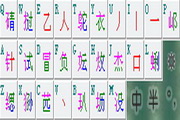Beginners only need to know one natural variation formula and three forced variations to easily achieve the goal of watching and playing without memorizing. The root status bar is composed of 26 cloth-keyed characters, with a total of 57 radicals. Most commonly used characters can be typed by typing two codes. For words that cannot be pronounced, another set of shaped pen rules can be used to simply type.
Qingyun version 1.1 is the final version of the original author. It has reorganized and optimized the word order of individual simplified codes, added some Chinese characters and nearly 10,000 colloquial phrases, and also comes with Qingyun Android version 1.1 for use on mobile phones. I hope to regain young people's love for glyph codes and contribute a small amount to alleviate the desertification of Chinese characters.

FAQ
1. Why can’t I type some words?
Answer: Although the only criterion for word splitting is "take the larger first and last word and leave a closed frame in the middle", some people still have ambiguities about the splitting of certain words, resulting in incorrect splitting. According to my analysis, there may be word splitting ambiguity in the following situations:
1) Whether the maximum radical is disassembled.
For example, the correct first and last root of the two characters "Wei and Mo" is "二小", and the wrong first and last root is "一木".
If there is indeed no maximum radical in the typing, use a single stroke. For example, the first and last root of "北" is "丨dagger", and the first and last root of "zhou" is "丿丶".
2) Whether the standard stroke order is disassembled.
For example, the standard stroke order of "Wu" is "Zhezhe and left horizontally", so the first and last character root is "Yiyi";
The standard stroke order of "桿" is "窿男使henghenghenghengheng", so the root of the first and last characters is "俿二".
3) Whether to separate component characters or conjoined Ge-shaped characters.
The separated component words are separated according to the order of components. For example, the first and last root of "medical" is "尚人", and the first and last root of "or" is "geyi".
For conjoined Ge-shaped characters, the conjoined horizontal strokes need to be cut off in the center. For example, the first and last root of "武" is "二彰", and the first and last root of "戢" is "口 Ge".
4) Other reasons.
Some people converted from Wubi font, and may be affected by Wubi when splitting characters. For example, the beginning and end of "Fei" are split into "刂二", which should actually be split into "丨二".
There are also some rare characters that are not included in the Qingyun version 1.1 font (7388 in total), so they have not been able to be typed.
2. Why do I sometimes feel that the word order is not optimized when typing, and some high-frequency words are displayed at the back?
Answer: Since the first character displayed can often be typed directly by typing the space, the advantage is very obvious over any characters listed after it, so a rigid rule was made when designing this input method:
All the first words displayed in the short code will lose priority in the long code and can only be displayed last. This includes the first-level short code words, so as to free up the first position displayed in the long code for the words in need. . In order to have more words ranked first in the display, the first word displayed in the short code is often given to the word with the heavy code. Therefore, high-frequency words may not necessarily be displayed at the front. This sorting is the result of a comprehensive balance between word frequency and repetition rate.
In the past, the short code display of Qingyun version 1.0 focused on the repeated code words as the first word, and the high-frequency words were almost always at the back. The user's typing experience was not good, but the typing efficiency was reduced. Now Qingyun version 1.1 has re-adjusted some simple code words and restored the first display position of short codes for some high-frequency words, making it more balanced between high efficiency and repeated code selection. Except for the first position, the short code display of Qingyun PC version cannot be displayed in complete order by word frequency due to software limitations, but the Qingyun Android version can.














































it works
it works
it works